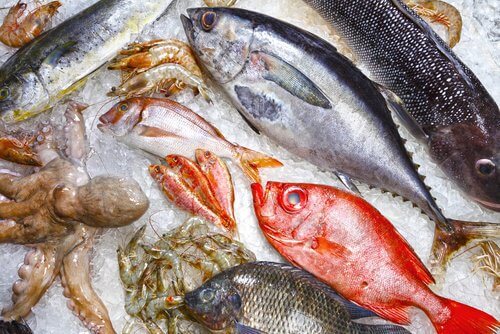9 Kinds of Unhealthy Fish That Are Better to Avoid


Reviewed and approved by the nutritionist Maria Patricia Pinero Corredor
Fish is one of the healthiest meats you can eat. However, there are certain kinds of unhealthy fish that are better to avoid.
Take note of them and choose other healthier options.
Unhealthy Fish to Avoid
1. Catfish

Since this can lead to some unhealthy fish, we recommend that you choose less toxic options.
2. Mackerel
Mackerel isn’t the most recommendable fish. This is because of its high mercury content.
Unfortunately, your body doesn’t get rid of mercury. Instead, it keeps building up. This metal is a substance that isn’t very healthy and can cause various diseases.
3. Blackfin tuna

Blackfin tuna has a lot of mercury.
Unfortunately, it’s almost impossible to find tuna that was raised in its natural habitat because it’s in danger of extinction.
The fish that you see for sale comes from special fish farms. At places like these, they feed the fish with antibiotics and hormones.
As a result, it’s a fish that also has a high mercury content. Thus, it’s not recommendable for an adult to eat more than 3.5 oz. per month.
This fish is never recommended for children.
4. Tilapia
Tilapia is a very fatty fish. It has a concentration of toxic fat that could compete with bacon.
If you eat too much of this fish, it will raise your level of bad cholesterol (LDL). Plus, it makes your body more sensitive to allergens.
If you suffer from heart disease, asthma, or arthritis, try to avoid Tilapia.
5. Eel

Eel is another very fatty fish. Eels easily absorb all kinds of residues found in the water. Because of this, the levels of toxins in American species is especially high.
As for European eels, they also have high mercury content. It’s not wise to eat more than 10 oz. for adults, and 7 oz. for children per month.
You might like: Try These Delicious Fish Fillet Recipes
6. Pangasius
Pangasius, a type of shark-like catfish, is raised in Vietnam in the Mekong river. This river is considered one of the most contaminated rivers in the world.
This kind of fish has high levels of mercury, nitrofural, and polyphosphates. Besides what we’ve already said about mercury, these last substances are carcinogenic.
Naturally, it’s one of the most unhealthy fish and it’s always recommended to avoid eating it.
7. Tilefish

Tilefish is a fish that has a high level of mercury contamination. Because of this, it’s not recommended for women or children.
For men, it should be limited to a maximum of 3.5 oz. per month.
8. Oilfish (white tuna)
Oilfish, also called white tuna, has gomphotoxin. This is a substance that is similar to wax and gives the meat an oily taste.
This substance isn’t digested by your body. Thus, it can cause bad digestion even though it isn’t very toxic.
To reduce the amount of gempilotoxin, we recommend you either fry or grill this fish. However, if you have digestive problems, it’s better to choose other options.
9. Rockfish

Sebastes, also known as yelloweye rockfish, has a lot of mercury.
In any case, it’s always better to choose healthier species and ones with less mercury.
Read: Eating Fish with Mercury During Pregnancy Linked to Autism
Fresh is always best
Also, it’s important to keep in mind that fresh fish has transparent eyes, a firm tail and wet, shiny scales. If you think that you’re buying supposedly fresh fish and the tail is limp, then it’s not as fresh as you think.
You can also see if it’s not fresh by looking at its fins. If its fins are dry and its gills are gray instead of red, it’s probably not fresh.
All cited sources were thoroughly reviewed by our team to ensure their quality, reliability, currency, and validity. The bibliography of this article was considered reliable and of academic or scientific accuracy.
- FDA. FDA/EPA. (2004). Advice on What You Need to Know About Mercury in Fish and Shellfish. Recuperado el 7 de marzo de 2021. https://www.fda.gov/food/metals-and-your-food/fdaepa-2004-advice-what-you-need-know-about-mercury-fish-and-shellfish
- Gracia, L., Marrugo, J. L., & Alvis, E. (2010). Contaminación por mercurio en humanos y peces en el municipio de Ayapel, Córdoba, Colombia, 2009. Revista Facultad Nacional Salud Pública. https://www.redalyc.org/articulo.oa?id=12016346003
- Heo, H. C., Lim, Y. H., Byun, Y. S., & Sakong, J. (2020). Mercury concentration in shark meat from traditional markets of Gyeongsangbuk-do, South Korea. Annals of occupational and environmental medicine, 32, e3. https://doi.org/10.35371/aoem.2020.32.e3
- H. H. Huss. (1998). El Pescado Fresco : Su Calidad y Cambios de su Calidad. FAO Documento Tecnico de Pesca. https://www.fao.org/3/v7180s/v7180s00.htm
- Kerguelén, M. (2021). Condiciones de exposición de la población habitante de la cuenca del río Atrato (municipio de Turbo) y su relación con niveles de mercurio en cabello producto de la actividad de minería de oro. Facultad de Ciencias de la Salud.
- Lowenstein, J. H., Burger, J., Jeitner, C. W., Amato, G., Kolokotronis, S. O., & Gochfeld, M. (2010). DNA barcodes reveal species-specific mercury levels in tuna sushi that pose a health risk to consumers. Biology Letters. https://doi.org/10.1098/rsbl.2010.0156
- Olivero, J., Mendonza, C., & Mestre, J. (1995). Mercurio en cabello de diferentes grupos ocupacionales en una zona de miner??a aurifera en el Norte de Colombia. Revista de Saúde Pública. https://doi.org/10.1590/S0034-89101995000500006
- Ortega, M. (2014). Niveles de plomo y mercurio en muestras de carne de pescado importado y local. Pediatría. https://doi.org/10.1016/S0120-4912(15)30135-X
- Polak-Juszczak L, Robak S. (2015). Mercury toxicity and the protective role of selenium in eel, Anguilla anguilla. Environ Sci Pollut Res Int. Jan;22(1):679-88. doi: 10.1007/s11356-014-3382-x. Epub 2014 Aug 8. PMID: 25099659.
- Righetti, M., Pascale, M., Giorgi, I., Forneris, G., Guarise, S., Tarasco, R., Arsieni, P., Abete, M. C., & Prearo, M. (2014). Livelli di contaminazione da cadmio, mercurio e piombo in siluri (Silurus glanis) pescati lungo il bacino idrografico del Fiume Po. Italian Journal of Freshwater Ichtyology, 1(1), 310–310. http://www.aiiad.it/ijfi/index.php/ijfi/article/view/71
- Rodríguez, M., Gutiérrez, Á. J., Rodríguez, N., Rubio, C., Paz, S., Martín, V., Revert, C., & Hardisson, A. (2018). Assessment of mercury content in Panga (Pangasius hypophthalmus). Chemosphere, 196, 53–57. https://doi.org/10.1016/j.chemosphere.2017.12.137
- Simopoulos AP. (2002). The importance of the ratio of omega-6/omega-3 essential fatty acids. Biomed Pharmacother. 2002 Oct;56(8):365-79. doi: 10.1016/s0753-3322(02)00253-6. PMID: 12442909.
This text is provided for informational purposes only and does not replace consultation with a professional. If in doubt, consult your specialist.








